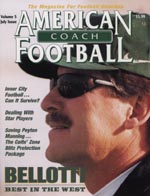AMERICAN FOOTBALL MONTHLY THE #1 RESOURCE FOR FOOTBALL COACHES
Article CategoriesAFM Magazine
|
The Warhawk Wayby: Bob BerezowitzHead Coach, Wisconsin-Whitewater © More from this issue Special teams practice and organization of time is always critical to any good football team. At UW-Whitewater, we have been very fortunate to have an offense that averages 40-plus points per game over the last three seasons. Along with a high-point average, comes a huge number of kick-offs and field position changes for our defense. We select kick-off coverage personnel mostly from the defensive side, particularly linebackers and defensive backs. Occasionally, we will use a fast, agile offensive or defensive lineman or tight end. Once our selection process has been determined, we begin to do our progression drills to teach coverage. During two-a-day session, we run a special segment in the morning while the remaining players are in an individual technique session. The first item we teach is proper spacing or field alignment....The full article can only be seen by subscribers.
|
|
|||||||
| HOME |
MAGAZINE |
SUBSCRIBE | ONLINE COLUMNISTS | COACHING VIDEOS |
Copyright 2025, AmericanFootballMonthly.com
All Rights Reserved





